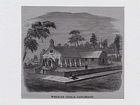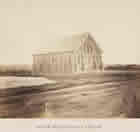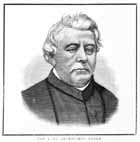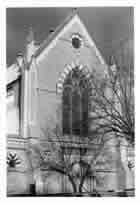Religion was present on the diggings from the outset. Initially, Christian services were held in the open air and conducted wherever there was a sufficient crowd – sermons were delivered atop tree stumps and on overturned wheelbarrows, by both clergymen and lay people. With cries and devices, people were notified of an impending service; at Forest Creek, the Episcopalian Reverend Cheyne drew a congregation by ringing his bell as he walked amongst the tents. As the diggings developed and a sense of permanency began to prevail, open-air services, and wooden or solid brick churches, replaced consecrated canvas tents.
Ministering religion on the goldfields was a difficult task for many clergymen. Not only did his ministry include many miles, thus requiring much arduous travel on poorly constructed roads, but the minister was also required to provide moral and spiritual enlightenment to an itinerant population that favoured notions of greed and wealth generated by gold mania. In an attempt to increase the number of Christian clergy at the diggings, and attract better quality ministers, the government increased their pay with money obtained from the gold revenue. Yet, despite these efforts, ‘the still unsettled life of the miner has not afforded a very encouraging field for the labors of the clergymen.’ Wesleyans were the first to establish churches, in both Mount Alexander and Ballarat, as they had a long tradition of lay preaching and were able to form congregations without permanent ministers. Catholic churches were slow to develop as the practice of their religion required consecrated priests.
Adhering to traditional practices, Sunday was observed as a day of meditation and rest, with miners refraining from their daily digging. On one rainy Sunday, the writer Edward Snell ‘smoked and read the Bible all day.’ Some diggers attended church services to fulfill their religious needs. Others joined the congregation for ulterior motives – it broke the monotony of a quiet Sunday, was an opportunity to socialise, or simply provided someone to listen to. After attending a service, John Castieau wrote in his diary: ‘I felt myself a hypocrite, for I knew it was not religion brought me, but desire to see and be seen.’ With few social outlets, church services offered more than just spiritual guidance and salvation.
For some people, though, the goldfields provided an opportunity to abandon their traditional religious practices. In delivering the first sermon at Mount Alexander, Reverend Mr Sullivan quoted in his text: ‘For what profiteth a man if he gain the whole world, and lose his own soul …’ Observing the service, an Argus correspondent noted ‘it was but thinly attended.’
As time progressed, and the polyglot of immigrants settled down into community life, non-Christian religious institutions were established. Ballarat’s first synagogue was built in 1855 and, at one stage, Castlemaine had five Joss Houses, which were the temples where Chinese deities were worshipped.






